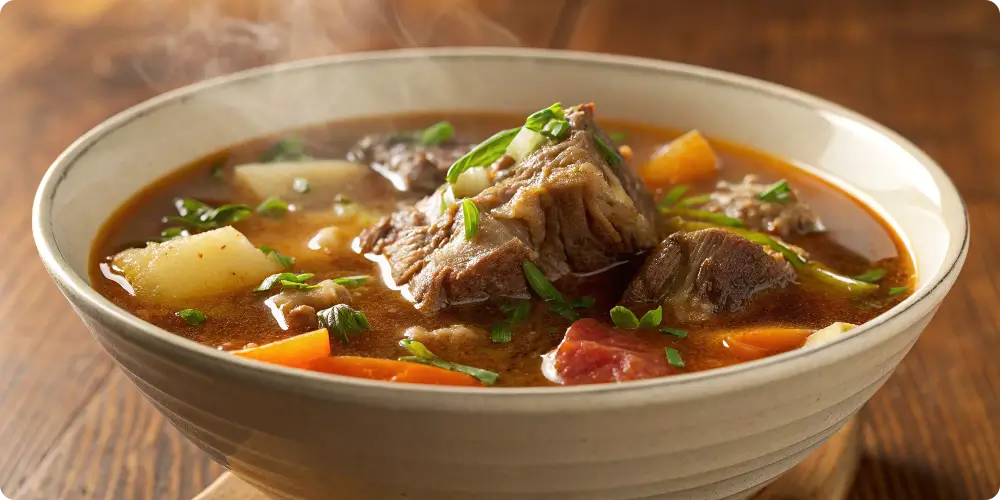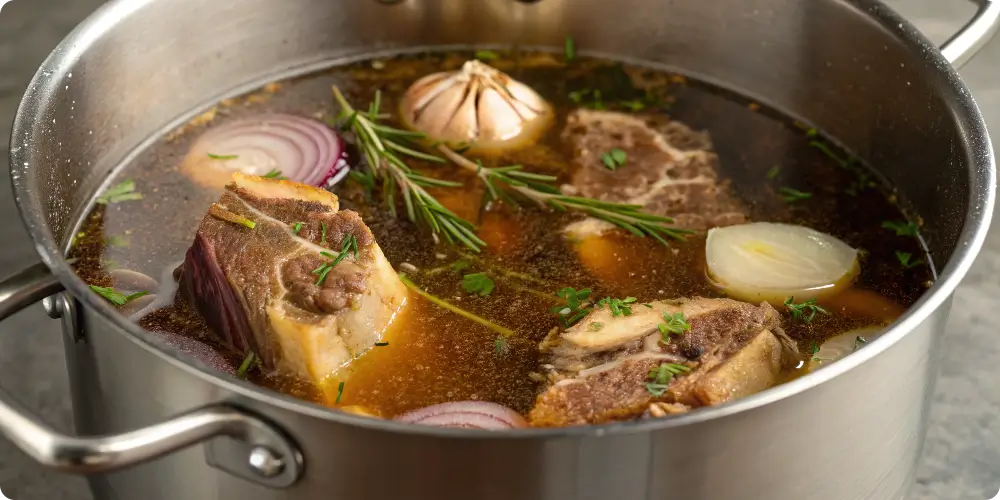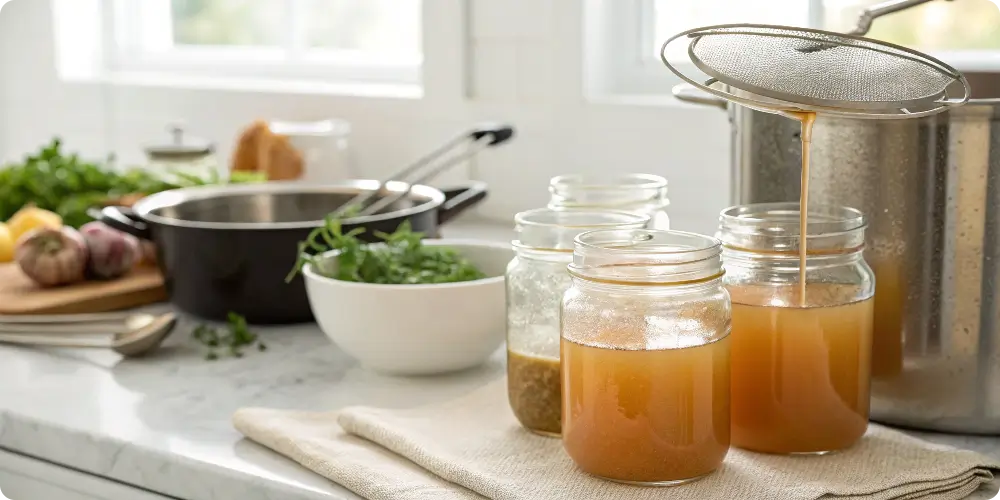Beef Knuckle Bones
Beef Knuckle Bones: How to Use Them for Broth, Nutrition, and Rich Flavor
When it comes to cooking deeply flavourful, nutrient-dense meals, few ingredients work harder than beef knuckle bones. Long valued by chefs, home cooks, and nutritionists alike, these dense, connective tissue-packed bones are ideal for creating rich broths, slow-cooked soups, and even homemade dog treats.
At Tasty Plated, we believe that cooking with traditional ingredients like beef knuckle bones isn’t just budget-friendly, it’s a smart, sustainable, and delicious way to bring more depth and wellness into your kitchen. With Chef Rachael’s guidance, this guide will show you how to source, use, and elevate these humble bones into something extraordinary.
• What Are Beef Knuckle Bones?
Beef knuckle bones come from the knee joint area of a cow. Unlike straight marrow bones, which are rich in fat, knuckle bones are loaded with connective tissue, collagen, and gelatin, making them perfect for bone broth and slow-simmered dishes.
They’re often sold raw at butcher shops, in meat markets, or frozen in bulk at international and specialty grocery stores. You can recognize them by their irregular shape, rough edges, and visible tendons and ligaments.
These bones typically contain:
Some marrow
Cartilage and tendons
Bits of meat and fat
Dense joint material

• Why Cooks and Nutritionists Love Knuckle Bones
Beef knuckle bones offer far more than flavour, they’re a nutritional powerhouse and an economical choice for everyday meals.
Health Benefits
Collagen-rich: Helps support joint, skin, and gut health
Protein and minerals: Natural source of calcium, phosphorus, magnesium
Low cost: Extremely affordable per pound
Slow-digesting: Helps regulate energy release in soups and stews
These bones are especially popular in ancestral diets, bone broth fasting, and anti-inflammatory meal plans. But even if you’re just here for the flavour, you won’t be disappointed.
• How to Make Beef Bone Broth Using Knuckle Bones
Making bone broth at home is simple, budget-friendly, and incredibly rewarding. Here’s a basic method using beef knuckle bones that yields a rich, gelatinous broth.
Ingredients
3–4 lbs beef knuckle bones
1 large onion, halved
2 carrots, chopped
2 celery stalks
1 tablespoon apple cider vinegar
3 garlic cloves
1 bay leaf
1 tsp peppercorns
Water (enough to cover the bones)
Instructions
Roast (Optional): Roast bones at 400°F for 30–40 minutes for deeper flavor.
Blanch (Optional): For a cleaner broth, blanch bones in boiling water for 10 minutes, then rinse.
Simmer: Add all ingredients to a large stock pot. Cover with cold water. Bring to a gentle boil, then reduce to a simmer.
Cook Time: Simmer for 12–24 hours. Add water as needed.
Strain: Let cool slightly. Strain through cheesecloth or fine mesh sieve.
Store: Pour into jars. Cool completely before refrigerating. Skim fat layer once solidified.
Use this broth as a base for soups, sauces, or drink it warm for gut health.

• Chef Rachael’s Bone Broth Method at Tasty Plated
At Tasty Plated, Chef Rachael treats broth like a culinary ritual, not just a recipe. Her method uses knuckle bones as the foundation for a broth that’s both healing and deeply flavourful.
Chef Rachael’s Tips:
Roast the bones: Adds bold, roasted depth
Add a splash of vinegar: Helps draw minerals and collagen from the bones
Use filtered water: Ensures a clean flavour
Simmer gently: A rolling boil creates cloudy broth; go slow and low
Cool naturally: Let broth cool gradually before refrigerating for best texture
“Knuckle bones are my go-to for texture,” Chef Rachael says. “They create that rich, gelatinous mouthfeel without needing any additives. It’s real food doing real work.”

• Table: Types of Beef Bones and Their Best Uses
| Bone Type | Location on Animal | Best Used For | Flavor/Texture Contribution |
|---|---|---|---|
| Knuckle Bones | Joint (knee) | Broth, soups, stews | Gelatinous, rich texture |
| Marrow Bones | Femur/leg center | Roasting, marrow spread | Fatty, intense, creamy |
| Neck Bones | Cervical spine | Braises, bone-in soups | Meaty, collagen-rich |
| Oxtail | Tail | Slow-cooked stews, soups | Deep flavour, gelatin-heavy |
| Shank Bones | Leg (lower) | Osso Buco, broths | Balanced meat and marrow |
This table helps you understand why beef knuckle bones are often the backbone (literally) of top-tier broths and stocks.
• Other Delicious Ways to Use Beef Knuckle Bones
While broth is the most common use, beef knuckle bones can also star in other dishes:
Slow-Cooked Stews
Add to chili or beef stew to boost richness and add collagen.
Beef Bone Pho
Use knuckle bones as part of your stock base for Vietnamese pho.
Red Wine Braise
Simmer bones with tomato paste, red wine, and herbs for a sauce base.
Pet Treats
After long simmering, discard sharp pieces, but soft bits can be mixed into pet food (check with your vet first).
• How to Store, Freeze, and Prep Knuckle Bones
Buying in bulk? Here’s how to prep your bones for storage and use.
Storing Raw
Wrap tightly and store in the refrigerator for up to 3 days.
Freezing
Freeze raw or roasted bones in freezer bags for up to 6 months.
Blanching Tip
Blanch for 10 minutes to remove blood and impurities. This keeps broth clearer and milder.
Make-Ahead Stock Packs
Create meal kits with knuckle bones, aromatics, and herbs all portioned in freezer bags for quick cooking.
• FAQs About Beef Knuckle Bones
1. What’s the difference between knuckle bones and marrow bones?
Knuckle bones have more connective tissue and less fat. Marrow bones are dense with rich, fatty marrow.
2. Can I use knuckle bones alone for bone broth?
Yes. They’re excellent solo, but combining with meaty bones adds more depth.
3. Are beef knuckle bones good for dogs?
Yes, but only if simmered to soften. Never give dogs raw or cooked hard bones that can splinter.
4. Do I need to roast the bones first?
Roasting adds flavour, but it’s optional. For lighter broths, skip roasting.
5. How long does homemade bone broth last?
Up to 5 days in the fridge. Freeze for longer storage.
6. Is bone broth from knuckle bones really more nutritious?
Yes, because of the high collagen and gelatin content from connective tissues.
• Final Scoop: Nourishing, Budget-Friendly, and Full of Flavor
Beef knuckle bones are one of the most underappreciated ingredients in the kitchen. Packed with collagen, flavour, and old-world cooking tradition, they’re the key to unlocking a better broth, and a better budget.
At Tasty Plated, Chef Rachael brings this ingredient to life with care and creativity, showing that something as humble as a joint bone can transform soups, stews, and sauces into deeply satisfying, nutrient-rich meals.
So whether you’re simmering for flavour or for health, don’t overlook the bones. The best dishes often start from the inside out.